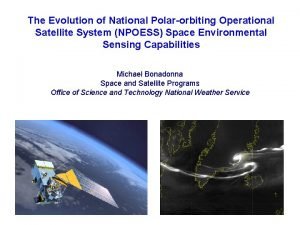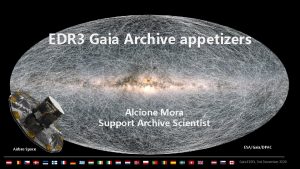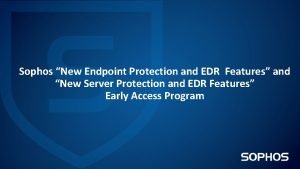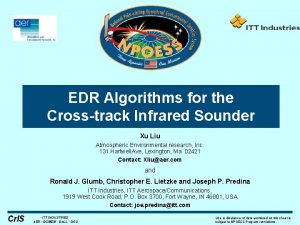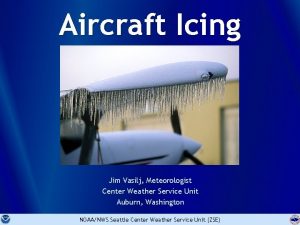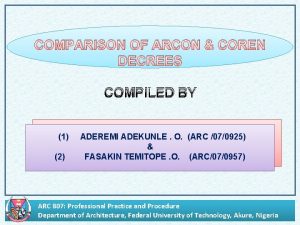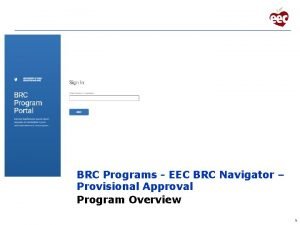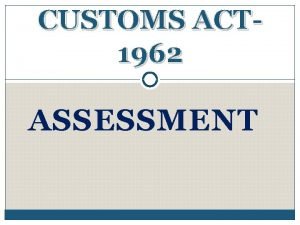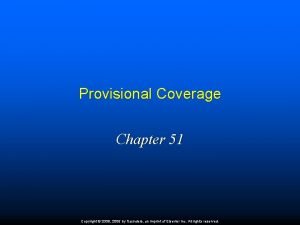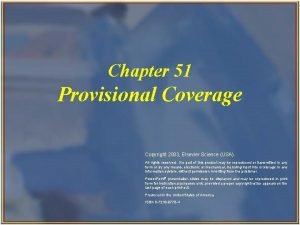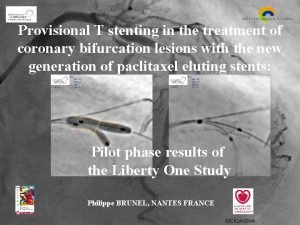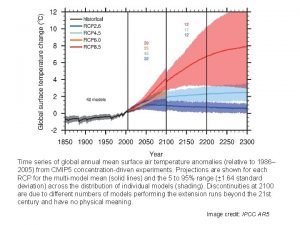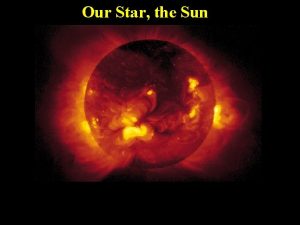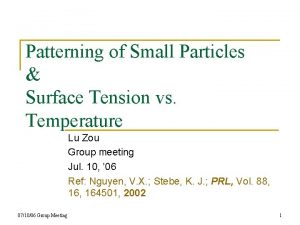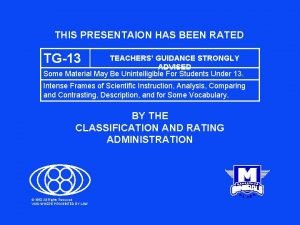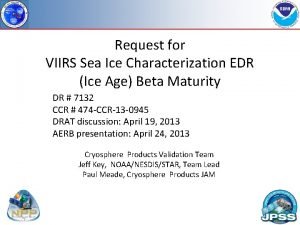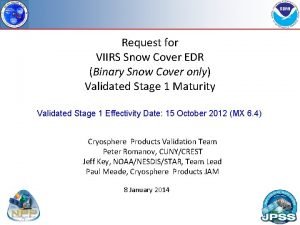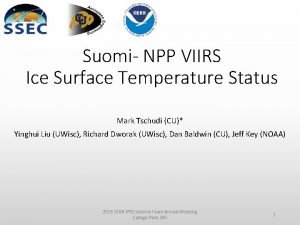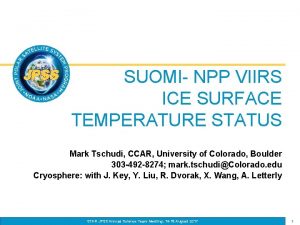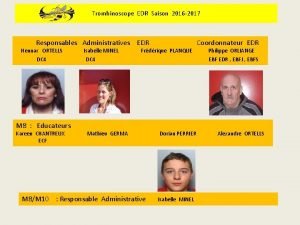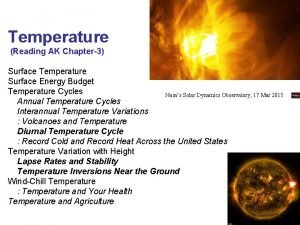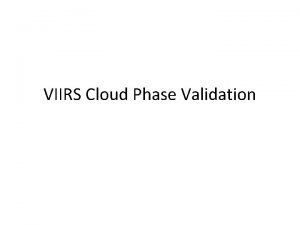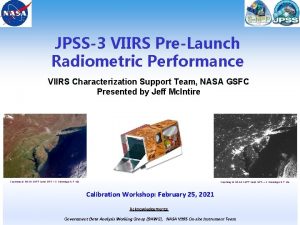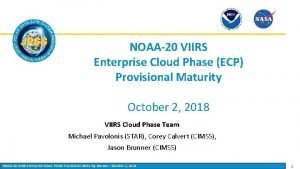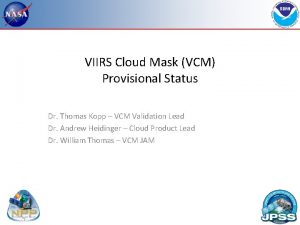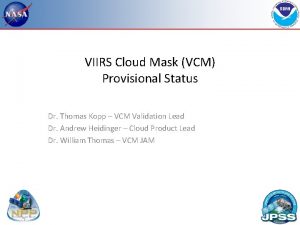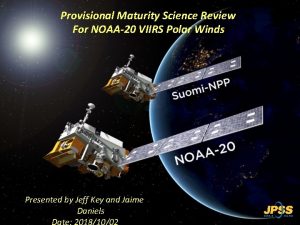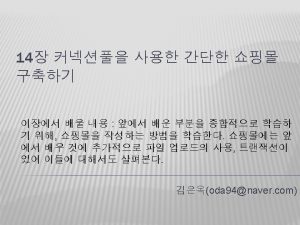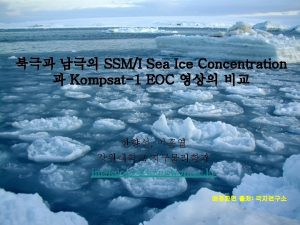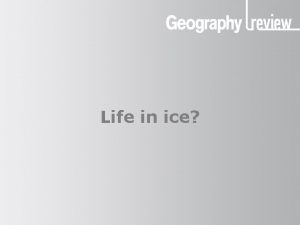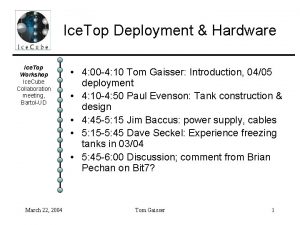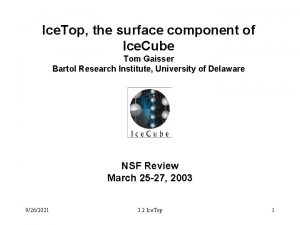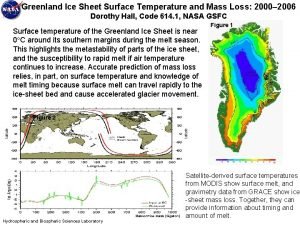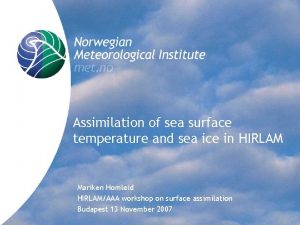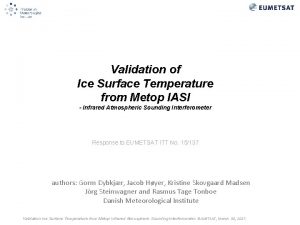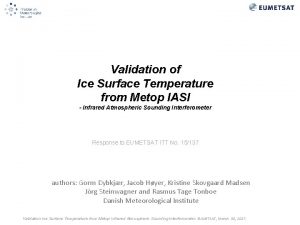Request for VIIRS Ice Surface Temperature EDR Provisional





























- Slides: 29

Request for VIIRS Ice Surface Temperature EDR Provisional Maturity Provisional Effectivity Date: 15 October 2012 (MX 6. 4) Cryosphere Products Validation Team Jeff Key, NOAA/NESDIS/STAR, Team Lead Paul Meade, Cryosphere Products JAM 22 August 2013

VIIRS Ice Surface Temperature 2

Outline • • • VIIRS IST EDR Users Provisional EDR Maturity Definition Summary of IST EDR VIIRS IST EDR requirements History of Algorithm Changes/Updates Provisional Maturity Evaluation Provisional Justification Summary Caveats of Operational VIIRS IST EDR Conclusions 3

VIIRS IST EDR Product Users • U. S. Users − − − − NIC, National/Naval Ice Center Naval Research Laboratory OSPO, Office of Satellite and Product Operations STAR, Center for Satellite Applications and Research University of Washington, Polar Science Center GSFC, NASA/Goddard Space Flight Center Hydrological Sciences Branch NWS, National Weather Service, including the Alaska Ice Desk CLASS, Comprehensive Large Array-data Stewardship System • User Community − − − Navigation Emergency Management Operational Weather Prediction Climate Research DOD 4

Provisional EDR Maturity Definition Product quality may not be optimal Incremental product improvements are still occurring Version control is in affect General research community is encouraged to participate in the QA and validation of the product, but need to be aware that product validation and QA are ongoing • Users are urged to consult the EDR product status document prior to use of the data in publications • Ready for operational evaluation • • 5

Summary of the VIIRS IST EDR • The VIIRS Ice Surface Temperature (IST) EDR provides surface temperatures retrieved at VIIRS moderate resolution, for snow/ice covered oceans for both day and night. • The baseline split window algorithm statistical regression method uses two VIIRS Infrared bands, 10. 76 μm (M 15) and 12. 01 μm (M 16) for both day and night and is based on the Advanced Very High Resolution Radiometer (AVHRR) heritage IST algorithm (Yu et al. , 1995). • IST EDR performance is dependent upon on the quality of the input SDR brightness temperatures, VIIRS Cloud Mask IP cloud confidence, Ice Concentration IP, Aerosol Optical Thickness IP and regression coefficients derived from matchups between the VIIRS M 15 and M 16 top of atmosphere (TOA) brightness temperatures and truth surface temperature sources for snow/ice covered ocean surfaces 6

Summary of the VIIRS IST EDR Algorithm Inputs VIIRS_ST_04 NPPx. DRs & IPs VIIRS 750 m SDR Ice Surface VIIRS 750 m TC GEO VIIRS Cloud Mask IP Temperature VIIRS Ice Concentration IP VIIRS Aerosol Optical Thickness IP Auxiliary Data VIIRS IST Tunable parameters VIIRS IST Regression Coefficient LUT Output EDRs & IPs. Ice Surface Temp. VIIRS EDR 7

Summary of VIIRS IST EDR Processing Flow For each pixel Determine Pixel Quality and set flags No retrieval quality check IST split window retrieval • determine day or night mode T IST split window if BT 15 valid range next pixel T F • IST split window regression set IST EDR to FILL IST single band retrieval • determine day or night mode • IST single band regression Check for invalid IST value range T set IST EDR to FILL F next pixel 8

VIIRS IST EDR L 1 RD Requirements Ice Surface Temperature (IST) “IST is the radiating, or "skin", temperature at the ice surface. It includes the aggregate temperature of objects comprising the ice surface, including snow and melt water on the ice. Inland water bodies and coastal ice temperatures will be obtained from the LST EDR. As an objective, the Ice Surface Temperature EDR shall measure the atmospheric temperature 2 m above the surface of the ice. 9

VIIRS IST EDR L 1 RD Requirements (Continued) Ice Surface Temperature (IST) Requirements from L 1 RD Supplement. V 2. 9 (27 June 2013) EDR Attribute Threshold Objective IST Applicable Conditions 1. Clear, only a. Sensing Depth Ice Surface b. Horizontal Cell Size 1. Nadir 2. Worst Case 1 km 1. 6 km 0. 1 km c. Mapping Uncertainty, 3 sigma 1. Nadir 2. Worst Case 1 km 1. 6 km 0. 1 km d. Measure Range 213 -275 K 213 -293 K (2 m above ice) RGB Image shows dense smoke (high absorption) in northwest, e. Measurement Uncertainty north central and central coastal portions of image. 1 K f. Refresh At least 90% coverage of the global every 24 hours (monthly average) 12 hrs g. Geographic Coverage Ice-covered oceans All ice-covered waters 10

Status of Upstream Products IST EDR performance is dependent on VIIRS SDR, VIIRS Cloud Mask IP, Ice Concentration IP, Aerosol Optical Thickness IP and IST Regression Coefficients – VIIRS SDR Cal and Geo products reached provisional maturity in March, 2013. – VIIRS Cloud Mask IP reached provisional maturity in February, 2013 – VIIRS Aerosol Optical Thickness reached beta maturity in September 2012 and provisional in March 2013 – VIIRS Ice Concentration IP reached beta maturity in March 2013. 11

Provisional Maturity Evaluation • Provisional Maturity Evaluation Approaches – Visualizations and quantitative comparisons of daily global gridded VIIRS IST, comparison with MODIS IST and NCEP surface air temperature, Ice Bridge flight IST – Time series analysis and bias analysis • NH analysis dates: 1/29/2012, 2/1/2012, 3/14/2012 • SH analysis dates: 4/10/2012 • Beaufort Sea analysis dates: 3/14/2012 (Ice. Bridge), 2/12/2012, 2/25/2012, 2/26/2012, 3/30/2012 • Terra Nova Bay analysis dates: 2/12/2012, 2/25/2012, 2/26/2012, 3/30/2012 12

Provisional Maturity Evaluation – Comparison VIIRS IST EDR with Ice. Bridge Flight IST Track of the NASA P-3 aircraft for the March 14, 2012 Ice. Bridge flight. UTC times are shown along the track. The P-3 flew at an altitude of 1000 ft over the sea ice. Among several instruments, it carried a KT-19: a downward-pointing, IR pyrometer that measures the surface temperature (in this case, the IST).

Provisional Maturity Evaluation – Comparison VIIRS IST EDR with Ice. Bridge Flight IST NASA's Land PEATE re-processed portions of the VIIRS IST EDR that are co-incident with Ice. Bridge flights over sea ice during March and April 2012. The resulting VIIRS IST EDR shows much better agreement with the ice surface temperature observed by the Ice. Bridge P-3 aircraft ‘s KT-19 instrument than the previous IST EDR data produced in March 2012. A comparison of IST measured by the NASA P-3 aircraft's KT-19 instrument (J. Yungel, PI) and the VIIRS IST EDR mean VIIRS = -33. 2 ˚C mean KT-19 = -33. 7 ˚C mean MODIS = -33. 4 ˚C RMS differences: VIIRS - KT-19 = 0. 6 ˚C MODIS- KT-19 = 1. 2 ˚C VIIRS – MODIS = 1. 1 ˚C Comparison between the IST (in deg C) measured by the KT-19 (in black, smoothed over 100 points), the nearest VIIRS IST measurement (in green) and MODIS observation (red). The comparison is for the leg from 16: 03: 37 -19: 10: 08 (west of -120 lon). The VIIRS overpass occurred from 16: 01 - 16: 06 UTC. VIIRS, MODIS, and the KT-19 IST's show consistent good agreement along the flight track, with VIIRS close to meeting the 0. 5 ˚C (or K) spec.

Provisional Maturity Evaluation – Comparison VIIRS IST with MODIS and NCEP Ice Surface Temperature (IST) EDR validation activities have shown that VIIRS IST has a 1 -2 K cold bias relative to the MODIS Ice Surface Temperature product. The bias for VIIRS Land Surface Temperature over the ice sheet (not shown) is less than for IST. VIIRS BT(11) Comparisons to NCEP and International Arctic Buoy Program MODIS IST (IABP) air temperatures show a similar spatial pattern but yield a VIIRS warm bias of 1 K or more, which is the opposite of the MODIS comparison. The comparison confirms the validity of the MODIS IST. VIIRS IST NCEP Ts 15

Provisional Maturity Evaluation – VIIRS IST vs MODIS IST VIIRS is biased low (too cold) relative to MODIS, though the bias is relatively small for most of the temperature range. Of greater concern is the uncertainty, which is large at higher temperatures. Histogram of ice surface temperature differences of NPP VIIRS and MODIS (Aqua and Terra) in February 2013 in the Arctic for all cases (upper left), and for cases with MODIS ice surface temperature in the ranges 230 -240 K, 240 -250 K, 250 -260 K, 260270 K, and 270 - 273 K. Measurement bias (bias) and measurement uncertainty (Prec) are indicated for each bin. 16

Provisional Maturity Evaluation – VIIRS IST vs MODIS IST Uncertainties of VIIRS ice surface temperature (IST) based on collocated VIIRS and MODIS (Terra and Aqua) from August 2012 to July 2013 for all cases in the Arctic (upper left), for all cases in the Antarctic (upper right), for cases in different MODIS IST intervals in the Arctic (lower left), and in the Antarctic (lower right).

Provisional Maturity Evaluation – NH comparison NCEP vs. VIIRS IST, Feb 27, 2012. Spatial patterns appear consistent.

Provisional Maturity Evaluation – global comparison VIIRS is biased high (warm) compared to NCEP reanalysis. However, the NCEP skin temperature used in this analysis is a forecast, not an analysis. This result is the opposite of the MODIS & Ice. Bridge results. 19

Provisional Maturity Evaluation – Cloud Mask Impacts Terra MODIS Day/night boundary (dashed green) VCM Region of discrepancy Ice/No Ice boundary from snow/ice rolling tiles (IVSIC, dotted green) Aqua MODIS The VIIRS Cloud Mask (VCM) continues to exhibit problems in the polar regions, which can significantly impact the snow and ice products. The figure above illustrates significant differences between daytime and nighttime, as well as discontinuities along ice/no-ice boundaries. 20

Discrepancy Reports (DRs) Date Update/DR# Reason Status 04 -17 -2013 7138 IST EDR OAD Corrections open 04 -17 -2013 7137 IST EDR ATBD Section 2. 3 Wording Error Correction open 11 -18 -2011 4457 EDR PR to define mid quality criteria open 11 -18 -2011 4456 EDR PR update to Define the exclusion criteria for quality summations open 11 -18 -2011 4455 Update EDR PR to define high quality retrievals open 12 -22 -2010 4136 ECR A-337 Dec 10 Look Up Table drop request closure 07 -17 -2009 2936 Ice Surface Temp and IST use different emissivities for ice Plan in place (next slide) 21

Path Forward Recommendation for DR 2936 Comparison of IST and Surface Temperature IP (ST IP) regression coefficients indicate that the IST coefficients currently implemented on the IDPS system are valid. However, inspection has revealed the ST IP split window coefficient value associated with view zenith angle dependence was erroneously set to 0. The review also uncovered a sign error in the ATBD equation (second line from the top, page 34). However, the code implementation is correct. Proposed path forward actions 1. Deliver updated STIP coefficients to close out DR 2936 2. Open DR to correct the IST ATBD equation appearing in the ATBD. The Equation should be t 11 = t. I + (1 -f)D instead of t 11 = t. I - (1 -f)D 22

Data Quality Threshold Tables (DQTT) Synthesizing from the EDR PR, the CDFCB-X Vol. VI, and the IST DQTT XML file: 1. There are three Data Quality Flags that are linked to potential Data Quality Notifications (DQNs): a) EDR Summary Quality - The percentage of pixels within a granule with a high retrieval quality b) Exclusion Summary - The percentage of pixels within a granule with excluded conditions c) Summary Range Check - The percentage of retrieved pixels outside of the expected range (213 K to 275 K) 2. For each of these, the current Data Quality Threshold Table (DQTT) specifies that a DQN will occur if (and only if) the percentage in question is less than 0% AND that this has occurred a minimum of 80 times. Furthermore, the DQN "severity" in each case (if one is issued) is "Normal" (i. e. , not severe). 3. The DQTT specifies that each of the three DQN is currently OFF (the <active> tag is "false"). This appears to be just a placeholder DQTT, as none of these can be triggered as currently specified. Therefore, the Cryosphere Team needs to develop either an internal (Cal/Val team only) or cooperative (Cal/Val team plus Raytheon OAA? ) plan to define appropriate DQTTs. After doing so, we will perform analysis using two days of orbits (Dec. 17 -18, 2012) to determine appropriate DQN thresholds for the three flags. 23

Provisional Justification Summary Product quality may not be optimal • • The product meets accuracy requirements under some, but not all, conditions. Evaluation is based on a limited number of focus days (global comparisons for retrieval products) The product has known flaws, but these products are of sufficient quality to justify use by a broader community. IST EDR contains retrievals over false ice retrieved by the VIIRS Sea Ice Concentration IP. Some false ice retrieved by the VIIRS Sea Ice Concentration IP has been linked to cloud leakage from a VIIRS Cloud Mask (VCM). Incremental product improvements are still occurring • • IST EDR surface temperature performance bias exists but is expected to improve with updated regression coefficients. The bias has been observed to be reduced with more recent IDPS code, primarily due to improvements in the VCM. While the performance of the VCM Cloud Confidence for day continues to improve with VCM tuning, improved performance for night will be dependent on the implementation of daily NOAA Multi-sensor Snow/Ice rolling tile updates and further tuning efforts. IST EDR performance is expected to benefit from improvements to resolve the current VCM bias toward over-prediction of confidently clear regions at night in polar regions. 24

Provisional Justification Summary Version control is in affect • (Description of the development environment, algorithm version (IDPS build number), and LUTs/PCTs versions used to generate the product validation materials. ) • ATBDs are accurate, up-to-date and consistent with the product running. General research community is encouraged to participate in the QA and validation of the product, but need to be aware that product validation and QA are ongoing • Cryosphere IST EDR team has evaluated IDPS EDR products available from CLASS. Users can access and read the products and the product compares reasonably with the heritage satellite snow map products 25

Provisional Justification Summary Users are urged to consult the EDR product status document prior to use of the data in publications • • Examination of the VIIRS IST EDR shows temperature over false ice retrieved by the Sea Ice Concentration IP. Such errors will be reduced with MX 8. 0 VIIRS Cloud Mask update and implementation additional quality checks in the Sea Ice Concentration IP for future builds beyond MX 8. 0 Current IST bias should be reduced with updated IST regression coefficients based on matchup of VIIRS M 15, M 16 TOA brightness temperatures with surface temperature truth. Evidence of lower bias has been shown with Ice. Bridge IST comparisons. Ready for operational evaluation • (Key NOAA and non-NOAA end users are identified and feedback requested. ) 26

Additional Supporting Documentation • TIM Meetings and Presentations – Cal/Val Team Meeting, April 2012 • Monthly/weekly reports https: //groups. ssec. wisc. edu/groups/jpss/cryosphere/reports 27

Future Plans and Issues • No code changes currently planned • Detailed performance characterization requires: – Update of IST regression coefficients based on matchup with VIIRS and truth IST sources – Improvements, consistency, and stability in the VIIRS cloud mask • Other actions: – Ability to check for reduced quality VIIRS Ice Concentration IP input based on quality flags with additional quality checks to be added to the Ice Concentration IP 28

Conclusion • VIIRS IST EDR has met the provisional maturity stage based on the definitions and the evidence shown – It exceeds the definition of provisional in most cases – Off-line EDR product performance overall is close to meeting requirements at this time and meets requirements in some cases. It continues to improve. • Some issues have been uncovered during validation and solutions are being evaluated. – Improvements in IST EDR performance may be realized as the VIIRS Cloud Mask IP matures and additional quality flags become available in the VIIRS Ice Concentration IP to avoid IST retrievals near clouds. • The provisional effectivity date is 15 October 2012 (MX 6. 4). VIIRS Cloud Mask IP improvements in this build notably improved product performance. 29
 Edr engineering
Edr engineering Edr
Edr Gaia edr
Gaia edr Edr
Edr Edr features
Edr features Edr
Edr Icing
Icing Clear ice vs rime ice
Clear ice vs rime ice Ferromagneti
Ferromagneti Difference between curie temperature and neel temperature
Difference between curie temperature and neel temperature Difference between curie temperature and neel temperature
Difference between curie temperature and neel temperature Arcon provisional registration
Arcon provisional registration Bccnp provisional license
Bccnp provisional license Eec brc provisionally approved
Eec brc provisionally approved Assessment of custom duty
Assessment of custom duty Types of provisional coverage
Types of provisional coverage Chapter 51 provisional coverage
Chapter 51 provisional coverage Din status provisional means
Din status provisional means Inverted provisional stenting
Inverted provisional stenting Global mean surface air temperature
Global mean surface air temperature Star
Star Surface tension vs temperature
Surface tension vs temperature Jupiter surface temperature
Jupiter surface temperature Surface area of a cone
Surface area of a cone Lateral surface area of triangle
Lateral surface area of triangle High surface tension vs low surface tension
High surface tension vs low surface tension Hur ser ett referat ut
Hur ser ett referat ut Atmosfr
Atmosfr Byggprocessen steg för steg
Byggprocessen steg för steg Vad är vanlig celldelning
Vad är vanlig celldelning

